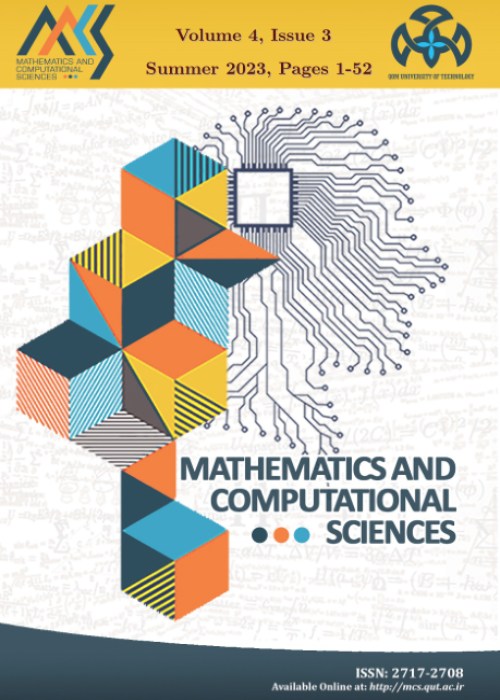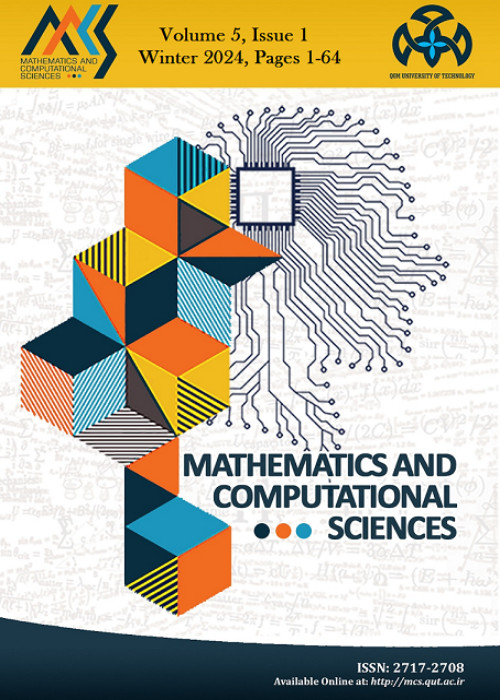فهرست مطالب

Mathematics and Computational Sciences
Volume:4 Issue: 3, Summer 2023
- تاریخ انتشار: 1402/06/10
- تعداد عناوین: 6
-
-
Novel existence results for sequential Caputo FDE with antiperiodic and integral boundary conditionsPages 1-12In this paper, by assuming certain assumptions, we study a novel class of sequential Caputo fractional differential equations (FDE) Consist of antiperiodic and Riemann-Liouville (R-L) fractional integral boundary conditions. The existence and uniqueness of the solution to the proposed class of problems utilizing the fixed point theory and some new equalities of norm form are investigated. At the end of the paper, two specific examples of the study results are offered to demonstrate its performance and effectiveness.Keywords: Fractional, Sequential, Antipriodic, existence, Uniqueness
-
Pages 13-18Leedham-Green and McKay [ Acta Math.137( 1967) 99-150] introduced the generalized version of the Baer-invariant of a group with respect to two varieties of groups. A group G is called capable if there exists a group H such that G=H/Z(H). In this paper , we generalize some properties of capability of direct product of groups with respect to two varieties of groups and direct Limits.Moreover, we survey some properties of the Baer - invariant of a pair of groups with respect to two varieties of groups and direct Limits.Keywords: Capable groups, Direct Limit, Baer-invariant
-
Pages 19-27
Tight frames and g-frames are extremely useful in applications. A scalable frame was recentlyintroduced as a frame with the property of generating a tight frame by rescaling its frame vectors. In thispaper, we generalize this concept to g-frames, introduce scalable g-frames, obtain some characterizationsfor them, and demonstrate that scalability is stable under unitary operators and isomorophisms betweentwo Hilbert spaces. In addition, we consider Paley-Wiener perturbations of g-frames and achieve someresults regarding the preservation of their g-frame property.
Keywords: Frame, Frame operator, G-Frame, scalable, Hilbert space -
Pages 28-33In is paper, we have studied the propagation of spatial solitons in the medium with a spatially modulated nonlinearity. Wave equation includes the terms of diffraction and periodic self- focusing. To solve the wave equation, we have employed numerical method including Monte Carlo based Euler-Lagrange variational schema. The effect of the nonlinearity strength related to periodic Kerr self-focusing, on the physical properties of the systems such as maximum intensity and soliton width oscillations are considered.Keywords: Spatial soliton, Variational approach, Monte Carlo, Periodic self-focusing
-
Pages 34-43We consider the spin-one DKP equation in the presence of vector Cornell and exponential interactions which are among successful interactions of particle physics. We obtain the exact analytical solutions of the former and the approximate solutions the latter via the Laplace integral transform method in terms of Hypergeometric functions for arbitrary quantum number in three spatial dimensions.Keywords: spin-one DKP equation, Cornell interaction, exponential interaction, Laplace Transform
-
Pages 44-52In this paper, modified laplace homotopy perturbation method(LHPM) is implemented to give approximate and analytical solutions of nonlinear ordinary differential equation systems model for HIV infection . Mathematical models have proven valuable in understanding the dynamics of HIV infection. By comparing these models to data obtained from patients undergoing antiretroviral drug therapy, it has been possible to determine many quantitative features of the interaction between HIV, the virus that causes AIDS, and the cells that are infected by the virus. We apply modified LHPM by setting a perturbation parameter and an embedding parameter as the damping parameter. Fourth-order Runge-Kutta method (RK4) is used to evaluate the effectiveness of the proposed algorithm. When we do not know the exact solution of a given problem, generally we use the RK4 method for comparison since it is widely used and accepted. Comparison of the results with RK4 method is confirmed that modified LHPM performs with very high accuracy. Results show that modified LHPM is a very promising method for obtaining approximate solutions to the model for HIV. The results validate the accuracy and efficiency of the proposed method for the approximate solution of the HIV infection model.Keywords: HIV, Nonlinear systems, modified laplace homotopy perturbation method


